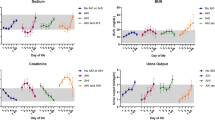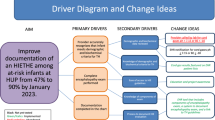Abstract
Objective
To evaluate multi-organ dysfunction (MOD) in newborns treated with therapeutic hypothermia (TH) for hypoxic ischemic encephalopathy (HIE), and to compare MOD in those with normal/mild magnetic resonance imaging (MRI) findings to those with moderate to severe MRI findings or death.
Study design
Retrospective single-center observational study of infants treated with TH. A total of 16 parameters across 7 organ systems were analyzed. Primary outcome was death or moderate to severe brain injury on MRI.
Result
Of 157 infants treated with TH, 77% had ≥2 organ systems with dysfunction. The number of organ systems with dysfunction was strongly associated with death or moderate-to-severe brain injury (p < 0.0001). Hematologic (68%) and hepatic (65%) dysfunction were most common. Neurologic and renal dysfunction were most strongly associated with the primary outcome (OR 13.5 [6.1–29.8] and 11.2 [4.1–30.3], respectively), while pulmonary hypertension was not.
Conclusion
MOD is prevalent in infants undergoing TH for HIE, and the association between MOD and adverse outcomes may impact clinical care and counseling.
This is a preview of subscription content, access via your institution
Access options
Subscribe to this journal
Receive 12 print issues and online access
$259.00 per year
only $21.58 per issue
Buy this article
- Purchase on SpringerLink
- Instant access to full article PDF
Prices may be subject to local taxes which are calculated during checkout




Similar content being viewed by others
Data availability
The data generated in this research will be shared on reasonable request to the corresponding author.
References
Volpe JJ, Inder TE, du Plessis AJ, de Vries LS, Perlman JM, Darras BT, et al. Volpe’s neurology of the newborn. 6th ed. Philadelphia, PA: Elsevier – Health Sciences Division; 2017. p. 1240.
Sheldon RE, Peeters LL, Jones MD, Makowski EL, Meschia G. Redistribution of cardiac output and oxygen delivery in the hypoxemic fetal lamb. Am J Obstet Gynecol. 1979;135:1071–8.
Peeters LL, Sheldon RE, Jones MD, Makowski EL, Meschia G. Blood flow to fetal organs as a function of arterial oxygen content. Am J Obstet Gynecol. 1979;135:637–46.
Jensen A, Garnier Y, Berger R. Dynamics of fetal circulatory responses to hypoxia and asphyxia. Eur J Obstet Gynecol Reprod Biol. 1999;84:155–72.
Shah P, Riphagen S, Beyene J, Perlman M. Multiorgan dysfunction in infants with post-asphyxial hypoxic-ischaemic encephalopathy. Arch Dis Child Fetal Neonatal Ed. 2004;89:F152–F155.
Committee on Fetus and Newborn, Papile L-A, Baley JE, Benitz W, Cummings J, Carlo WA, et al. Hypothermia and neonatal encephalopathy. Pediatrics. 2014;133:1146–50.
Perlman JM, Wyllie J, Kattwinkel J, Atkins D, Chameides L, Goldsmith JP, et al. Part 11: Neonatal resuscitation: 2010 International Consensus on cardiopulmonary resuscitation and emergency cardiovascular care science with treatment recommendations. Circulation. 2010;122(16 Suppl 2):S516–538.
Shah PS. Hypothermia: a systematic review and meta-analysis of clinical trials. Semin Fetal Neonatal Med. 2010;15:238–46.
Bhagat I, Sarkar S. Multiple organ dysfunction during therapeutic cooling of asphyxiated infants. Neoreviews. 2019;20:e653–e660.
Alsina M, Martín-Ancel A, Alarcon-Allen A, Arca G, Gayá F, García-Alix A. The severity of hypoxic-ischemic encephalopathy correlates with multiple organ dysfunction in the hypothermia era. Pediatr Crit Care Med. 2017;18:234–40.
Sweetman DU, Strickland T, Isweisi E, Kelly L, Slevin MT, Donoghue V, et al. Multi-organ dysfunction scoring in neonatal encephalopathy (MODE Score) and neurodevelopmental outcomes. Acta Paediatr. 2022;111:93–8. https://doi.org/10.1111/apa.16111
Shankaran S, Laptook AR, Ehrenkranz RA, Tyson JE, McDonald SA, Donovan EF, et al. Whole-body hypothermia for neonates with hypoxic-ischemic encephalopathy. N Engl J Med. 2005;353:1574–84.
Laptook AR, Shankaran S, Tyson JE, Munoz B, Bell EF, Goldberg RN, et al. Effect of therapeutic hypothermia initiated after 6 h of age on death or disability among newborns with hypoxic-ischemic encephalopathy. JAMA. 2017;318:1550–60.
Bonifacio SL, Glass HC, Vanderpluym J, Agrawal AT, Xu D, Barkovich AJ, et al. Perinatal events and early magnetic resonance imaging in therapeutic hypothermia. J Pediatr. 2011;158:360–5.
Rutherford M, Ramenghi LA, Edwards AD, Brocjlehurst P, Halliday H, Levene M, et al. Assessment of brain tissue injury after moderate hypothermia in neonates with hypoxic-ischaemic encephalopathy: a nested substudy of a randomized controlled trial. Lancet Neurol. 2010;9:39–45.
Bach AM, Fang AY, Bonifacio S, Rogers EE, Scheffler A, Partridge JC, et al. Early MRI predicts 30-month outcomes after therapeutic hypothermia for neonatal encephalopathy. J Pediatr. 2021;238:94–101.
Guirado L, Crispi F, Soveral I, Valenzuela-Alcaraz B, Rodriguez-López M, García-Otero L, et al. Nomograms of fetal right ventricular fractional Area change by 2D echocardiography. FDT. 2020;47:399–410.
Jone P-N, Ivy DD. Echocardiography in pediatric pulmonary hypertension. Front Pediatrics. 2014;2:1–15. 124
Koestenberger M, Ravekes W, Everett AD, Stueger HP, Heinzl B, Gamillscheg A, et al. Right ventricular function in infants, children and adolescents: reference values of the tricuspid annular plane systolic excursion (TAPSE) in 640 healthy patients and calculation of z score values. J Am Soc Echocardiogr. 2009;22:715–9.
Giesinger RE, El Shahed AI, Castaldo MP, Breatnach CR, Chau V, Whyte HE, et al. Impaired right ventricular performance is associated with adverse outcome after hypoxic ischemic encephalopathy. Am J Respir Crit Care Med. 2019;200:1294–305.
Mehta RL, Kellum JA, Shah SV, Molitoris BA, Ronco C, Warnock DG, et al. Acute Kidney Injury Network: report of an initiative to improve outcomes in acute kidney injury. Crit Care. 2007;11:R31.
Zappitelli M, Ambalavanan N, Askenazi DJ, Moxey-Mims MM, Kimmel PL, Star RA, et al. Developing a neonatal acute kidney injury research definition: a report from the NIDDK neonatal AKI workshop. Pediatr Res. 2017;82:569–73.
Pakvasa MA, Winkler AM, Hamrick SE, Josephson CD, Patel RM. Observational study of haemostatic dysfunction and bleeding in neonates with hypoxic-ischaemic encephalopathy. BMJ Open. 2017;7:e013787.
Phelan JP, Alen MO, Korst L, Martin G, Wang YM. Intrapartum fetal asphyxial brain injury with absent multiorgan system dysfunction. J Matern Fetal Med. 1998;7:19–22.
Mainali KP, Slud E, Singer MC, Fagan WF. A better index for analysis of co-occurrence and similarity. Sci Adv. 2022;8:eabj9204.
Hellström-Westas L, Rosén I, Svenningsen NW. Predictive value of early continuous amplitude integrated EEG recordings on outcome after severe birth asphyxia in full term infants. Arch Dis Child Fetal Neonatal Ed. 1995;72:F34–38.
Toet M, Hellstrom-Westas L, Groenendaal F, Eken P, de Vries LS. Amplitude integrated EEG 3 and 6 h after birth in full term neonates with hypoxic-ischaemic encephalopathy. Arch Dis Child Fetal Neonatal Ed. 1999;81:F19–F23.
Thoresen M, Hellström-Westas L, Liu X, de Vries LS. Effect of hypothermia on amplitude-integrated electroencephalogram in infants with asphyxia. Pediatrics. 2010;126:e131–139.
Myers RE. Two patterns of perinatal brain damage and their conditions of occurrence. Am J Obstet Gynecol. 1972;112:246–76.
Myers RE. Four patterns of perinatal brain damage and their conditions of occurrence in primates. Adv Neurol. 1975;10:223–34.
Martín-Ancel A, García-Alix A, Gayá F, Cabañas F, Burgueros M, Quero J. Multiple organ involvement in perinatal asphyxia. J Pediatr. 1995;127:786–93.
Jacobs SE, Berg M, Hunt R, Tarnow-Mordi WO, Inder TE, Davis PG. Cooling for newborns with hypoxic ischaemic encephalopathy. Cochrane Database Syst Rev. 2013;2013:CD003311.
Carter BS, McNabb F, Merenstein GB. Prospective validation of a scoring system for predicting neonatal morbidity after acute perinatal asphyxia. J Pediatr. 1998;132:619–23.
Sarkar S, Askenazi DJ, Jordan BK, Bhagat I, Bapuraj JR, Dechert RE, et al. Relationship between acute kidney injury and brain MRI findings in asphyxiated newborns after therapeutic hypothermia. Pediatr Res. 2014;75:431–5.
Selewski DT, Jordan BK, Askenazi DJ, Dechert RE, Sarkar S. Acute kidney injury in asphyxiated newborns treated with therapeutic hypothermia. J Pediatr. 2013;162:725–9.e1.
Bonifacio SL, McDonald SA, Chock VY, Wusthoff CJ, Hintz SR, Laptook AR, et al. Differences in patient characteristics and care practices between two trials of therapeutic hypothermia. Pediatr Res. 2019;85:1008–15.
Segar JL, Chock VY-L, Harer MW, Selewski DT, Askenazi DJ, Newborn Brain Society Guidelines and Publications Committee. Fluid management, electrolytes imbalance and renal management in neonates with neonatal encephalopathy treated with hypothermia. Semin Fetal Neonatal Med. 2021;26:101261. https://doi.org/10.1016/j.siny.2021.101261
Tarcan A, Ti˙ker F, Güvenir H, Gürakan B. Hepatic involvement in perinatal asphyxia. J Matern Fetal Neonatal Med. 2007;20:407–10.
Agarwal P, Shankaran S, Laptook AR, Chowdhury D, Lakshminrusimha S, Bonifacio SL, et al. Outcomes of infants with hypoxic ischemic encephalopathy and persistent pulmonary hypertension of the newborn: results from three NICHD studies. J Perinatol. 2021;41:502–11.
Barkovich AJ, Hajnal BL, Vigneron D, Sola A, Partridge JC, Allen F, et al. Prediction of neuromotor outcome in perinatal asphyxia: evaluation of MR scoring systems. AJNR Am J Neuroradiol. 1998;19:143–9.
Hayes BC, Ryan S, McGarvey C, Mulvany S, Doherty E, Grehan A, et al. Brain magnetic resonance imaging and outcome after hypoxic ischaemic encephalopathy. J Matern Fetal Neonatal Med. 2016;29:777–82.
Funding
EY received salary support from the Einstein Research Fellowship.
Author information
Authors and Affiliations
Contributions
ESY conceptualized and designed the study, collected the data, extracted the data from the electronic medical record, analyzed the data, drafted the manuscript, and adjusted the manuscript according to the comments of the co-authors. VYC conceptualized and designed the study, supervised data collection, critically appraised the analysis of the data, wrote, and critically reviewed the manuscript for important intellectual content. SLB extracted the data from magnetic resonance imaging, critically appraised the analysis of the data, wrote, and critically reviewed the manuscript for important intellectual content. AD analyzed the data, appraised the analysis of the data, wrote, and critically reviewed the manuscript for important statistical content. CVG extracted the data from magnetic resonance imaging, critically appraised the analysis of the data, and critically reviewed the manuscript for important intellectual content. GA conceptualized and designed the study, extracted the data from echocardiograms, appraised the analysis of the data, and critically reviewed the manuscript for important intellectual content. SB critically appraised the analysis of the data and critically reviewed the manuscript for important intellectual content. KVM conceptualized and designed the study, supervised data collection, critically appraised the analysis of the data, wrote, and critically reviewed the manuscript for important intellectual content. All authors approved the final manuscript as submitted and agree to be accountable for all aspects of the work.
Corresponding author
Ethics declarations
Competing interests
The authors declare no competing interests.
Ethics approval
This study was approved by the Institutional Review Board of Stanford University.
Additional information
Publisher’s note Springer Nature remains neutral with regard to jurisdictional claims in published maps and institutional affiliations.
Supplementary information
Rights and permissions
About this article
Cite this article
Yan, E.S., Chock, V.Y., Bonifacio, S.L. et al. Association between multi-organ dysfunction and adverse outcome in infants with hypoxic ischemic encephalopathy. J Perinatol 42, 907–913 (2022). https://doi.org/10.1038/s41372-022-01413-6
Received:
Revised:
Accepted:
Published:
Issue Date:
DOI: https://doi.org/10.1038/s41372-022-01413-6



